Philadelphia, Pennsylvania
Philadelphia is among the "most Lithuanian" cities in the USA and has the fourth largest total number of ethnic Lithuanians after Chicago, New York, and Los Angeles (~6000)
It has 3 great Lithuanian churches, pre-war art nouveau Lithuanian halls, a synagogue named after Vilnius, and an abandoned Lithuanian cemetery in its suburbs.
Lithuanian Music Hall in Philadelphia
The prettiest and the last one surviving among Philadelphia's Lithuanian clubs is its especially old (erected 1908) Lithuanian Music Hall, also known as Lietuvių namai ("Lithuanian House") in Lithuanian language and "Big Lit" in English (2715 E. Allegheny Ave). It is a separate red brick building inspired by art nouveau.
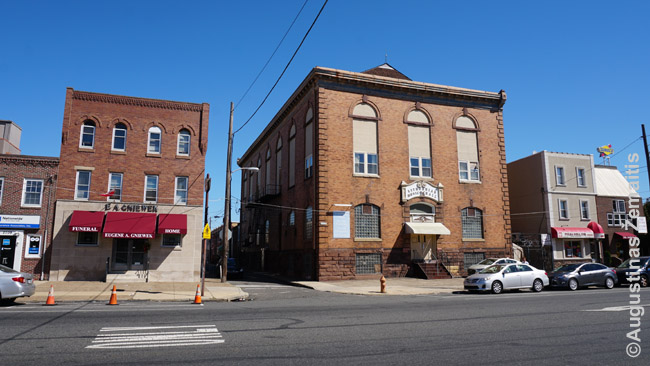
Lithuanian Music Hall in Philadelphia.
Inside, there are three halls, of which the upper floor one is the most impressive. It is named after M.K. Čiurlionis, Lithuania's most famous painter. Previously, it had full arched windows, but those have been partly bricked up during the war shortage times.
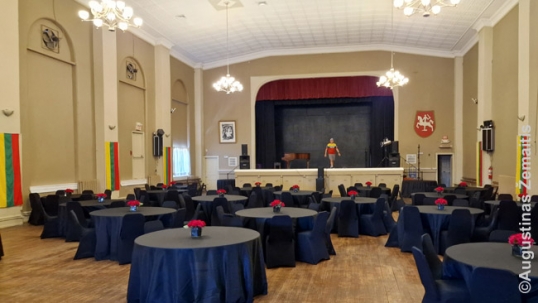
The upper hall of the Lithuanian Music Hall
In the basement, the Hall has an exhibition of Lithuanian arts, both folk and professional, and documents and maps related to the history of Lithuania and Philadelphia Lithuanians. This is the Surdėnas Lithuanian cultural center, established in 1980 and renovated ~2021. There is also a Lithuanian book library. You may also see the authentic heating system from the pre-WW1 era in that room.
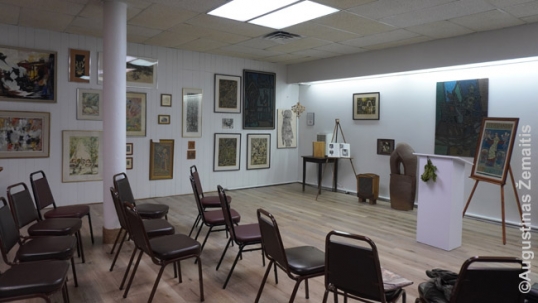
The basement museum of Lithuanian Music Hall
The hall hosts many Lithuanian activities and an annual fair. To this day, it also hosts Lithuanian concerts of the musicians arriving from Lithuania.

Musicla instrument detail at the Lithuanian Music Hall.
The surrounding district is mostly Polish (it is still strong on that identity). Poles too, however, come at the Music Hall's fair and other events.
In 2017, the Lithuanian Music Hall was in peril. There were plans by its mostly elderly owners to sell the building. However, seeing this, some new Lithuanian immigrants joined the organization and took over the management of the building, thus saving it as a Lithuanian cultural hub. The building was renovated.
Lithuanian National Hall in Philadelphia
The second Lithuanian Club of Philadelphia, known as the Lithuanian National Hall, used to be located close to 2nd Avenue. Its building still stands and the name is still chiseled in stones but it has been remodeled into apartments (the Lithuanian Club closed in 1984). In a way it's going back to the roots as when the Hall was completed in 1900 it also included apartments. Afterward, the expanding Club needs and rental halls had pushed the residential use out.

Lithuanian National Hall in Philadelphia.
St. Andrew: the grandest of Philadelphia's Lithuanian churches
Philadelphia still has all three of its Lithuanian churches open.
Towered neo-romanesque St. Andrew Church (1913 Wallace St.) still hosts Sunday mass in Lithuanian. The building has been acquired from Protestants in 1942 after the Great Depression and War shattered hopes of the parish to erect its own new building.

St. Andrew Lithuanian church in Philadelphia.
St. Andrew has a grand interior, the most impressive among Philadelphia's Lithuanian churches.

St. Andrew Lithuanian church in Philadelphia (interior).
Despite the non-Lithuanian origins of the building, St. Andrew's church has many Lithuanian details, ranging from a freestanding wayside cross outside to a true "Shrine of Lithuanian history" inside.
On that shrine, one may see a railroad going towards a cross, which is a symbol of the Soviet Genocide (1940-1953) when hundreds of thousands of Lithuanians, some third of them children and babies, were forced into cattle carriages and moved to the ice-cold Siberia where many of them died due to cold, hunger, forced labor, and other reasons.
There is also a cross with images of the victims of the January 13, 1991 massacre, a final Soviet bid to stop Lithuanian independence. Lithuanian civilians were stopping the tanks with their bodies then and many died. Vilnius TV Tower, one of the key locations Soviets attempted to take over, is also painted there. There is also the Our Lady of Vilnius in a folk-craft-inspired wooden frame and a Lithuanian flag.
Soviet Genocide is an important topic here, as much of the congregation has originated in the refugees who fled Lithuania before the Soviet re-occupation in 1944. These refugees always saw themselves as exiled people, as staying in Lithuania would have meant death to nearly all of them (or another exile to Siberia, a much worse location).

St. Andrew 'Shrine of Lithuanian history'. From left to right: American, Lithuanian, and Vatican flags; the Soviet Genocide painting; the Mary painting in a folk-craft frame; the TV tower painting; the cross with images of those killed in January 13, 1991.
The church also has Lithuanian religious images. Over the altar, Lithuanians Mečislovas Reinys (a Lithuanian priest killed for refusing to collaborate with the Soviets) and Marija Kaupaitė (the venerable founder of a Lithuanian-American nun order) are painted. Near the altar, Jurgis Matulaitis, a beatified Lithuanian has his image in a large folk-art frame. Outside, there is a Lithuanian wooden cross.

St. Andrew Lithuanian church in Philadelphia Mečislovas Reinys and Marija Kaupaitė over the altar, with a traditional Lithuanian sun-cross in between.
There are still some curious details left from the Episcopal era, such as numbered pews (in the Episcopal church, they used to be rented to families but in the Lithuanian church, anybody is free to sit anywhere). Before using this church, the Episcopals had a small church nearby. Today, it is also owned by the Lithuanian parish and used as a parish hall, as well as Vincas Krėvė Saturday school where Philadelphia Lithuanian kids learn the Lithuanian language and culture.
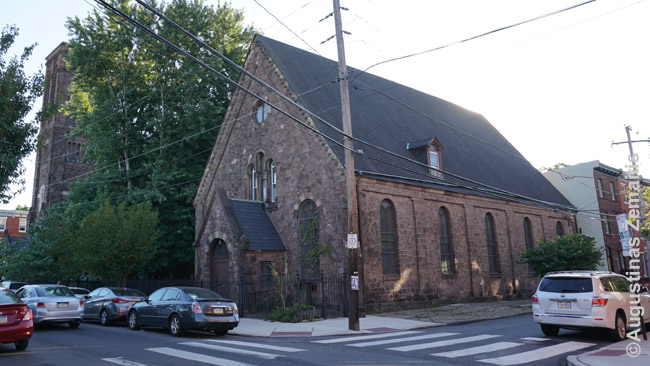
Exterior of the former Episcopal church (now St. Andrew parish hall and Vincas Krėvė school).
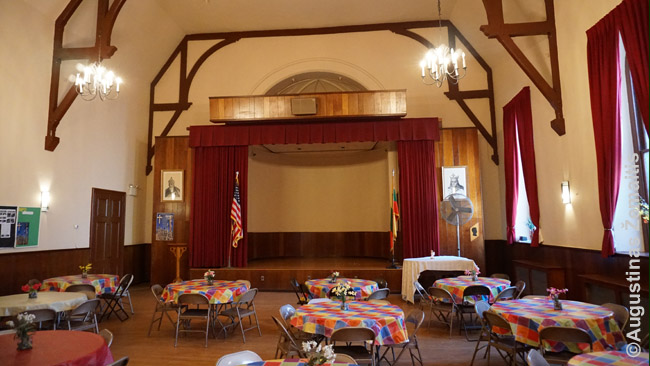
St. Andrew Lithuanian church in Philadelphia parish hall.
There were Lithuanian details even in the rectory of St. Andrew's, however, it has been sold ~2022.
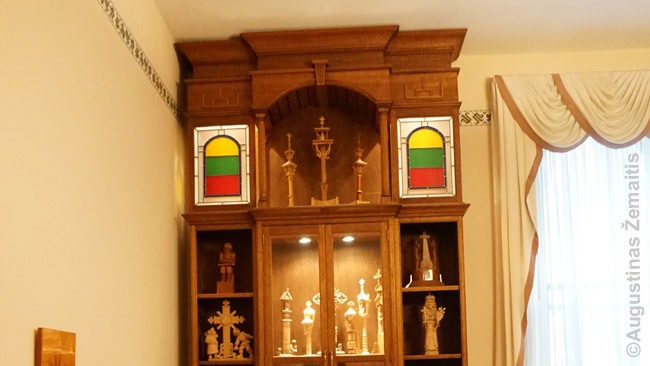
Lithuanian details at the sacristy of St. Andrew.
St. Casimir: the most Lithuanian church in Philadelphia
While St. Andrew Lithuanian church has many Lithuanian details, it couldn't compare with St. Casimir Lithuanian church of Southern Philadelphia (324 Wharton Street).

St. Casimir Lithuanian church in Philadelphia. A Lithuanian tricolor is waving nearby.
There, the Lithuanian details are nearly countless. At the entrance, a Lithuanian quote "Izenk geras, iseik gerensis" ("Enter a good person, leave a better one") greets the people. Inside, the stations of the cross are all done on Lithuanian designs, there are paintings like the opening of St. Casimir's grave in Vilnius Cathedral, there are stained glass windows of Marija Kaupas and much more.

St. Casimir Lithuanian church in Philadelphia stations of the cross, with Lithuanain inscriptions and Lithuanian traditional ornamentation. A Lithuanian tricolor is waving nearby.
In fact, nearly everything here has a relation to both religion and Lithuania. For example, among the images of the saints, blessed people, and the venerable, many are either from Lithuania or Lithuanian-Americans. The Lithuanian atmosphere was supported by priest Petras Burkauskas, a long-term Lithuanian priest in the church (1996-2021).

Altar of the St. Casimir Lithuanian church in Philadelphia. The slogoan on tops, surrounded by two Lithuanian flags, declares: 'St. Casimir. Wonderful on earth, more wonderful in heaven.'
Outside, there is a traditional Lithuanian chapel-post and the inscription at its bottom even describes it as having both Christian and Pagan motifs. This is a fact, as the Lithuanian folk motifs (such as the sun often found on the traditional crosses) are undoubtedly pagan-inspired even though undeniably Christian today. Yet, few churches dare to recognize this. However, Lithuanian-American churches are built on two pillars, religious and ethnicity, and that ethnic pillar includes the non-Christian Lithuanian history as well.

St. Casimir Lithuanian church in Philadelphia entrance. A Lithuanian tricolor is waving nearby.
St. Andrew is also the sole place among Philadelphia Lithuanian buildings where a Lithuanian tricolor is permanently waving.
St. Casimir is the oldest Lithuanian church (parish established in 1893) but the current building was erected after a fire in 1930. In 2007 its 100-year old school has been closed while in 2011 the parish has been amalgamated with St. Andrew but the church remaine dopen.
St. George: the church of blue-collar Lithuanians
St. George Lithuanian church (3580 Salmon Street) has two floors, the first of them built for a school and still used as such. Non-Lithuanian kids predominate now, but the entrance still has Vytis (the Lithuanian Coat of Arms) on it and there are other Lithuanian details inside. Stations of the cross have Lithuanian inscriptions, there is a medal to the Lithuanian king Jogaila and much more.

St. George Lithuanian church in Philadelphia.
The St. George church building was erected in 1920, with the school being preferred to a tower. The former church building stands nearby, now serving as a parish hall.
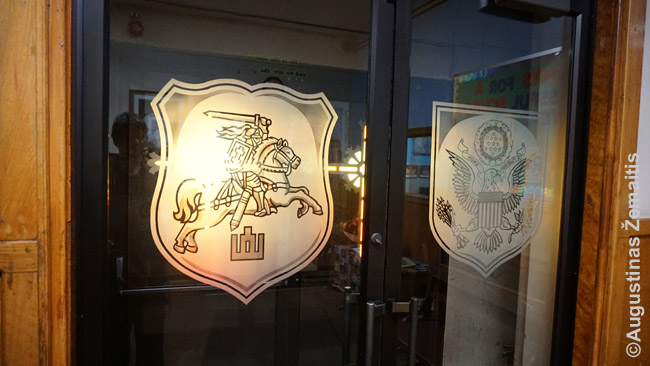
St. George Lithuanian church in Philadelphia. Entrance with the Lithuanian Coat of Arms.
Traditionally, St. George church used to be frequented by the blue-collar Lithuanian workers (in contrast to St. Andrew, which was a domain of intellectuals, especially the Soviet-Genocide-refugees). Therefore, it is the most modest among the three Philadelphia Lithuanian churches. Still, it has nice Lithuanian-donated stained glass windows with donors' names under them.
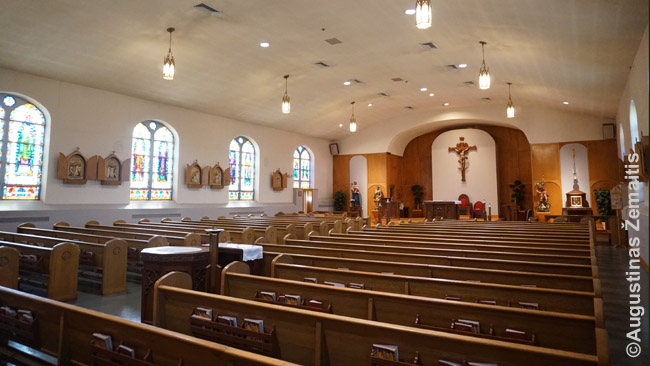
St. George Lithuanian church in Philadelphia interior.

The bottom of St. George Lithuanian church in Philadelphia stained glass windows with Lithuanian donors marked.
Vilna Congregation (Vilnius synagogue) in Philadelphia
A rather unique Lithuania-related site is the Vilna Congregation, named after Vilnius, the capital of Lithuania (Vilna being its old Russian name). This is a synagogue located in a house once owned by Shapiro, a Jewish person from Vilnius. He promised God that should his business succeed, he'd donate his home for the religion (and this is what happened). He cquired the building in 1915 and registered it as synagogue in 1922. The inscription chiselled in stone above the entrance reads (in Hebrew script) - "The Avraham Aba Bar Shapira and Men of Vilna Synagogue established in the year 5665".

Vilna Congregation synagogue in Philadelphia (exterior).
Eventually, the original "Men of Vilnius" who worshipped there have left the area and the synagogue is now kept by the Chabad Lubavitch movement. While it has few worshippers, the rabbis seek to keep it open.

Vilna Congregation synagogue in Philadelphia.
The word "Vilna" is still visible on numerous locations inside. The synagogue, however, has collected donor plaques from the area's other synagogues, so, not every plaque is originating at Vilna Synagogue. There is also the establishment charter on the second floor, as well as newspaper clippings about the synagogue's history and the images of the synagogue founders who came from Vilnius.

Vilna Congregation synagogue in Philadelphia plaque with 'Vilna' name mentioned.
The synagogue is usually closed outside of prayer times.
Lithuanian Republican Citizens' Club
Port Richmond neighborhood that is the home for St. George Lithuanian church as well as the Lithuanian Music Hall also has a third Lithuanian-originated institution known as Lithuanian Republican Citizens' Club. While it still operates, it now operates more as a private bar without ethnic activities. As of 2022, it has ~60-70 members of whom only one is a true Lithuanian. An abbreviation "L.R.B.C." is remaining on the sign outside (it means Lithuanian Republican Beneficial Club).

Lithuanian Republican Club
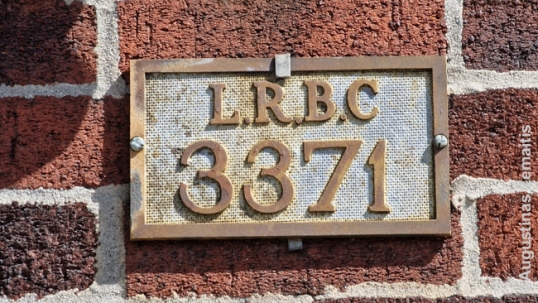
Lithuanian Republican Club abreviation
Bensalem abandoned Lithuanian cemetery (National Catholics)
The saddest Lithuanian site in Philadelphia is the abandoned Lithuanian cemetery at Bensalem suburb (est. 1926). Once owned by the unique and independent Lithuanian National Catholic church, the cemetery became abandoned after most Lithuanians returned from that church to the Vatican-led Roman Catholic church.

Bensalem Lithuanian cemetery entrance.
Currently, the cemetery is so overgrown that it requires a painful push through spiky plants to access some of the graves (what you see near the road is just part of the cemetery; the other parts are deeper into the forest). Still, that makes the cemetery unique and interesting to those who like such abandoned sites.
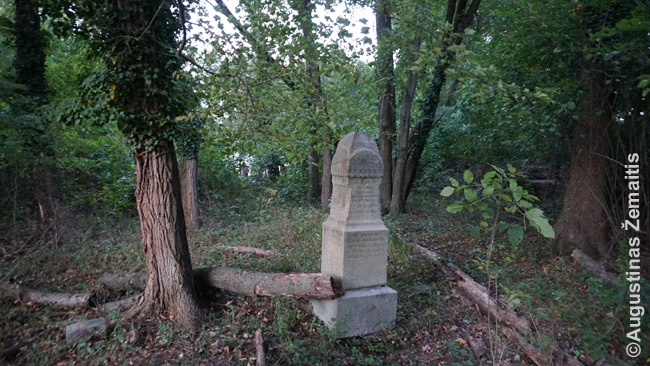
A grave deep inside the Bensalem Lithuanian cemetery.
The Lithuanian National Catholic parish existed in years 1926-1957 and had some 400 members at the start. Their St. Mary church was located at 331 Reed Street which is now an empty lot.
Lithuanian churches of Chester (PA) and Camden (NJ)
In addition to the Philadelphia's three Lithuanian churches in the city-proper, there were two more Lithuanian churches in the Philadelphia suburbs of Chester and Camden (NJ). Both of these buildings have been demolished, however. Chester church has been closed in 1972.
Villa Joseph Marie High School
Villa Joseph Marie high school was established in 1932 as a Catholic school for mainly Lithuanian girls by the Sisters of St. Casimir, a Lithuanian female monastic order of USA. It originally used the historic Maria Hall but got a new building in 1957. A nursing home used to stand on the grounds back then as well, now its former premises have been assumed by the school.
Lithuanian memorabilia near Philadelphia's Independence Hall
Philadelphia is the birthplace of US independence and, as such, it has inspired independence movements elsewhere in the world, especially so during the ~1850-1950 century when the global empires were slowly disintegrating. During World War 1, the opportunity to declare independence reached Lithuania and Central Europe. Thus, in 1918, delegates of various Central European nations, among them Lithaunians, met in Philadelphia to sign their declaration of common aims. This declaration is now exhibited in the museum of Philadelphia's Independence Hall.
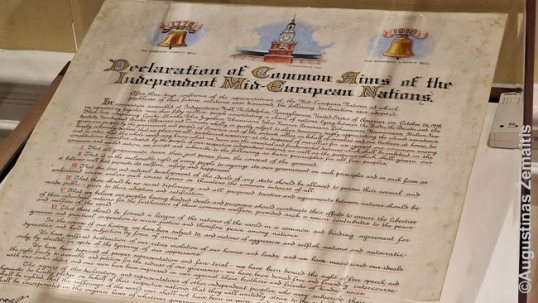
Declaration of Common Aims
Recommended literature: "Where Have All the Lithuanians Gone? A Study of St. Casimir’s Lithuanian Parish in South Philadelphia"
The map
All the Lithuanian locations, described in this article, are marked on this interactive map, made by the "Destination - America" expedition (click the link):
Interactive map of Philadelphia Lithuanian sites
Destination America expedition diary
|
Philadelphia may be the Lithuanian America as it once was. All three of its Lithuanian churches are open, two of them decorated elaborately with many Lithuanian details by their long-term priest Petras Barkauskas.
There is a Philadelphia Lithuanian school with its own premises, there is yet another Lithuanian priest Joseph Anderlonis (who guided us around), and the Lithuanian St. George Lithuanian parish still has its own parish school open. There is also the Philadelphia Lithuanian Music Hall, a great art nouveau-styled edifice with a lyre above its entrance. It is older than the Republic of Lithuania itself. And there is even a synagogue named after Vilnius – in a house donated by a Jewish man who made a promise to God to do that if his business succeed. The rabbi we met considered the synagogue’s survival quite miraculous on itself since it is so small and easily convertible back into a house; however, a cooperation of different groups of Jews made it possible. However, dangers are looming on top of the Philadelphia Lithuanian sites, as there are talks to sell the Lithuanian Music Hall, cutting its 110-year-old Lithuanian history for good. It would be a pity to lose yet another key Lithuanian-American site, especially since the Hall could be easily saved if there would be more cooperation among different groups of Lithuanian forces in America: if the “old Lithuanian-Americans” who are currently the ones caring for the Hall would be joined by the Lithuanian embassy and consulates, the “new Lithuanian-Americans”, the descendants of the “old Lithuanian-Americans”, the Lithuanian-Americans from outside Philadelphia, the non-Lithuanian Americans who are into heritage protection, and more. It depends on all of us to prevent Philadelphia from becoming yet another once-very-Lithuanian American city where barely anything Lithuanian remains! Augustinas Žemaitis, 2017 10 02. |

Tikslas - Amerika vadovas Augustinas Žemaitis su Filadelfijos lietuviais Šv. Andriejaus parapijos salėje
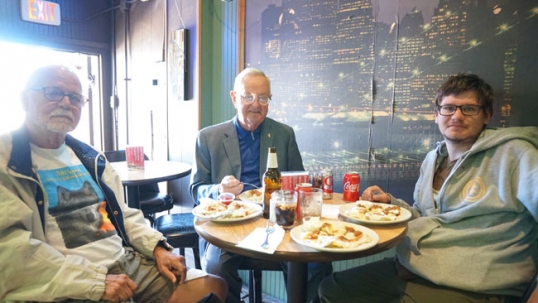
Tikslas - Amerika projekto vadovas Augustinas Žemaitis su Filadelfijos lietuvių muzikos salės atstovais




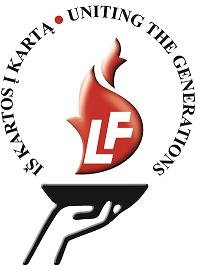

December 4th, 2017 - 02:31
Paspaudus ant aprašomo objekto pavadinimo gerai būtų, jei nukreiptų į tą vietą Google Maps.
December 4th, 2017 - 08:28
Turime “Google Maps” paremtą žemėlapį, kuriame visos Filadelfijos lietuviškos vietos tiksliai pažymėtos: http://map.truelithuania.com/filaladelfija-lietuvisku-vietu-planas/ . Ateityje įdėsime aiškesnę nuorodą į šį žemėlapį.
October 29th, 2018 - 00:48
Pardon my English, I am researching my husband’s family. His grandmother Agnes was born in Philadelphia in about 1913 to Eva (Zemaitis or Jawaitis) Warikieny [daughter of Michael Zemaitis or Jawaitis and Mary (unknown)] and John Waraikis (John’s surname spelling is speculative based on the surname of Eva (Warikieny) as listed on her subsequent marriage record). John is believed to have passed away before 1919, then Eva married Liudvikas Lavrinavitz about 31 May at St Casimir’s in Philadelphia . Eva and Liudvikas (who changed his name to Louis upon later naturalization) moved to Ohio and then the Chicago area. Louis and Eva had one child together, Margaret. Can you point me to someone who can assist me in finding records for them in Philadelphia? Any help is greatly appreciated.
November 2nd, 2018 - 14:23
I think you should contact the Philadelphia Lithuanian institutions: the Philadelphia Music Hall, the St. Andrew-St. Casimir parish, St. George parish.
November 5th, 2021 - 09:49
Brangieji,
….nuostabi perapija ir bendruomenė, mačiau lietuvoje prašo kunigo, kad pagelbėtų pastoracijai. Dievas telaimina šiuos norus…
Maldoje
Kun.prof.dr.Kęstutis Ralys